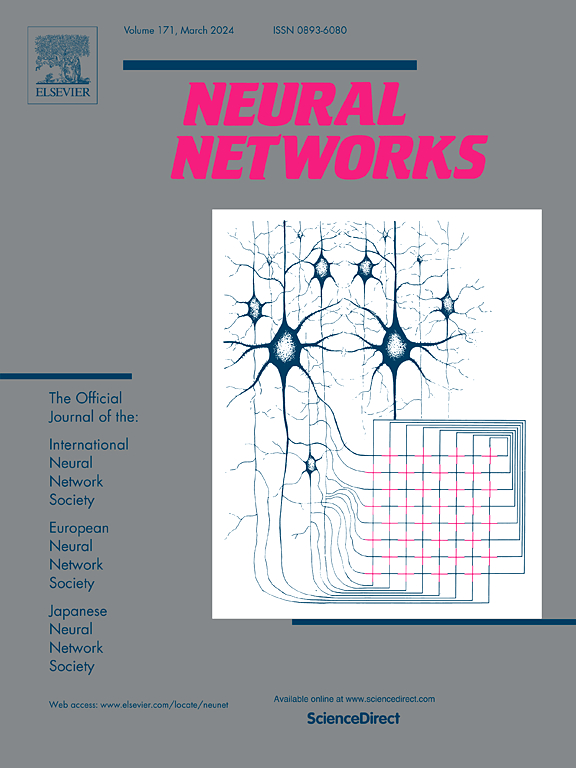中心损失引导协调变压器可靠的解剖地标检测
IF 6
1区 计算机科学
Q1 COMPUTER SCIENCE, ARTIFICIAL INTELLIGENCE
引用次数: 0
摘要
基于热图的解剖地标检测仍然面临两个未解决的挑战:(1)无法准确评估热图的分布;(2)无法有效利用全球空间结构信息。为了解决计算能力不足的挑战,我们提出了一种新的位置感知和样本感知中心损失。具体来说,我们的中心损失可以吸收位置信息,从而能够准确地评估热图分布。更高级的是,我们的中心损失是样本感知的,它可以自适应区分容易和硬样本,使模型更专注于硬样本,同时解决了地标和非地标极端不平衡的挑战。为了解决忽略结构信息的挑战,提出了一种协调变压器(CoorTransformer),该变压器在地标坐标信息的指导下建立远程依赖关系,在利用全局空间结构的同时使注意力更加集中在稀疏的地标上。此外,CoorTransformer可以加快收敛速度,有效避免了transformer在稀疏表示学习中难以收敛的缺陷。利用先进的CoorTransformer和中心损失,我们提出了一个广义的检测模型,该模型可以处理各种场景,固有地利用地标之间的潜在关系,并结合目标地标周围丰富的结构知识。我们在三个具有挑战性的地标检测任务中分析和评估了CoorTransformer和central loss。实验结果表明,我们的CoorTransformer优于最先进的方法,中心损失显著提高了模型的性能,p值为<;0.05。该工作的源代码可在GitHub存储库中获得。本文章由计算机程序翻译,如有差异,请以英文原文为准。
Central loss guides coordinated Transformer for reliable anatomical landmark detection
Heatmap-based anatomical landmark detection is still facing two unresolved challenges: (1) inability to accurately evaluate the distribution of heatmap; (2) inability to effectively exploit global spatial structure information. To address the computational inability challenge, we propose a novel position-aware and sample-aware central loss. Specifically, our central loss can absorb position information, enabling accurate evaluation of the heatmap distribution. More advanced is that our central loss is sample-aware, which can adaptively distinguish easy and hard samples and make the model more focused on hard samples while solving the challenge of extreme imbalance between landmarks and non-landmarks. To address the challenge of ignoring structure information, a Coordinated Transformer, called CoorTransformer, is proposed, which establishes long-range dependencies under the guidance of landmark coordinate information, making the attention more focused on the sparse landmarks while taking advantage of global spatial structure. Furthermore, CoorTransformer can speed up convergence, effectively avoiding the defect that Transformers have difficulty converging in sparse representation learning. Using the advanced CoorTransformer and central loss, we propose a generalized detection model that can handle various scenarios, inherently exploiting the underlying relationship between landmarks and incorporating rich structural knowledge around the target landmarks. We analyzed and evaluated CoorTransformer and central loss on three challenging landmark detection tasks. The experimental results show that our CoorTransformer outperforms state-of-the-art methods, and the central loss significantly improves the model’s performance with -values . The source code of this work is available at the GitHub repository.
求助全文
通过发布文献求助,成功后即可免费获取论文全文。
去求助
来源期刊

Neural Networks
工程技术-计算机:人工智能
CiteScore
13.90
自引率
7.70%
发文量
425
审稿时长
67 days
期刊介绍:
Neural Networks is a platform that aims to foster an international community of scholars and practitioners interested in neural networks, deep learning, and other approaches to artificial intelligence and machine learning. Our journal invites submissions covering various aspects of neural networks research, from computational neuroscience and cognitive modeling to mathematical analyses and engineering applications. By providing a forum for interdisciplinary discussions between biology and technology, we aim to encourage the development of biologically-inspired artificial intelligence.
 求助内容:
求助内容: 应助结果提醒方式:
应助结果提醒方式:


